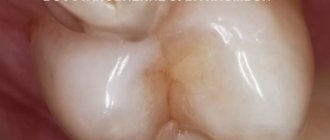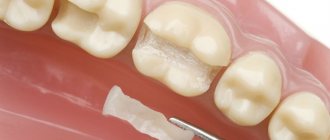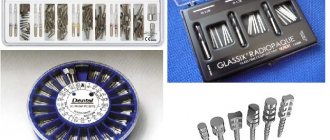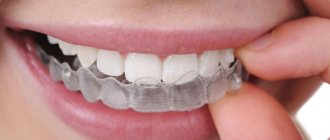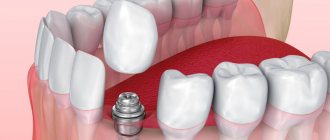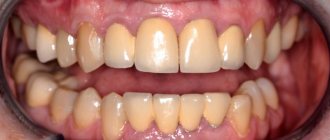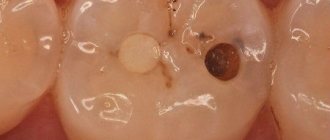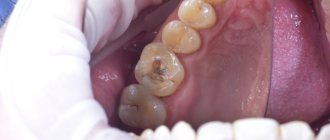Dental inlays
have been used in dental treatment for a long time, but many people still have not even heard of this technology for tooth restoration.
Meanwhile, a dental inlay is better than a large filling or crown. We decided to talk about microprosthetics with dental inlays with maxillofacial surgeon, dentist Tamara Kazbekovna Alakaeva
.
Tamara Kazbekovna, what is a dental inlay?
A dental inlay is a microprosthetic tooth that completely imitates its missing parts (anatomical and functional). The dentist prepares the tooth, takes an impression and sends it to the dental laboratory, after which the dental technician makes an inlay.
Is a dental inlay an alternative to a filling or crown?
Yes, today a dental inlay is a modern alternative to both a filling and a crown.
The inlay is more durable than a regular filling, since the filling contains various micropores, from which caries develops over time (microflora gradually accumulates in microcracks and micropores, causing the development of carious lesions). The inlay fits more tightly to the tooth, so nothing accumulates under it. In addition, the use of a dental inlay provides a more uniform and correct load on the tooth. Unlike fillings, ceramic inlays do not wear out over time and do not change in color or volume. All of the above qualities of dental inlays are their advantages over fillings and crowns.
The only disadvantages of dental inlays include, perhaps, the higher cost and the longer amount of time required for their manufacture. If a regular filling is installed for the patient directly on the day of the appointment, then the manufacture and installation of the inlay requires at least two visits with an interval of at least 7 days, since the dental inlay is made in a dental laboratory.
But the patient must understand that if the tooth is significantly damaged, then the installed filling will not last long. An inlay costs more than a filling, but it lasts about ten years, and with good hygiene – even longer. Many people change their fillings once a year or even every six months. Therefore, the tab is actually cheaper than several fillings that will have to be installed in its place.
How much does it cost to install one tab?
The price of the inlay consists of the cost of the material from which it is made and the work of the doctor and dental technician. In Moscow, a ceramic inlay for one tooth costs on average from 25 to 35 thousand rubles. In addition to ceramic, metal, plastic, composite, and zirconium inlays are installed. The insert can even be made from noble metals (gold).
It turns out that noble metals are still actively used in dental prosthetics?
Not really. Gold inlays
Usually installed on patients who are allergic to metal.
Such patients do not suspect that they have such an allergy and find out about it after the installation of the structure. Therefore, if a person has never had any artificial structure in the oral cavity, he needs to do an allergy test. Ceramic materials
, which are more expensive than metal, are not allergenic. This is their important advantage.
Composite
- this is a material used to make fillings; dental inlays are also made from it; they are about 30% cheaper than ceramic ones.
Made of plastic
Temporary structures are usually made. If the patient’s tooth is fully prepared for the installation of an inlay, and it is impossible to make a temporary filling, he can be given a temporary plastic inlay.
When is a filling needed?
If less than a third of the tooth is damaged, then in most cases the doctor restores it using filling materials. Modern photopolymer fillings
allow you to recreate the shape and color of a natural crown, add aesthetics to the surface, and adjust the position of the unit.
But in case of serious damage, a large filling is often (!) placed in the cavity, which will not withstand long-term significant loads. If a tooth has been depulped, then over time its walls become fragile and further destruction occurs. When the carious cavity is large, restoring the destroyed tooth crown with a regular filling is acceptable, but does not guarantee long-term preservation.
Types of veneers
Microprostheses are divided into composite and porcelain. Composite ones are divided into:
- Direct
Made in the patient's mouth. Installation technology: the doctor grinds the coronal shell to a thickness of 0.3-0.7 mm and forms an overlay layer-by-layer from a material identical to that used in filling. The procedure is completed by grinding and polishing the surface of the microprosthesis. In part, the technique has something in common with artistic dental restoration.
- Indirect (componers)
They are made in a dental laboratory (like ceramic analogues). Impressions are taken from dental units prepared for restoration, from which thin plates are made using computer equipment. They have an increased precision of fit to the enamel surface. This guarantees a long service life of orthopedic structures.
When wondering which veneers are better to choose, composite or ceramic, you should first understand the features of the options. Each type has its own advantages and disadvantages in terms of aesthetics, reliability and price.
What is a tab
Veneers are used to restore the beauty of the front teeth and strengthen them.
Stump tab
used to strengthen molars. More often it is a mini-prosthesis that completely repeats the shape of the internal destroyed part of the crown. It is inserted into the tooth and secured with a special dental compound.
Such structures are a good way to restore a tooth. The inlay is used when the destruction of the natural crown exceeds 30% and there is a healthy root.
Their service life is 20 years or more, the materials tolerate chewing loads and correspond to the anatomical structure of the tooth. Their shade remains unchanged under the influence of food coloring. There are options:
- Restorative
, their role is close to the function of a filling. They are attached to the top of the unit without touching the channels. - Stump mini-prostheses
. Such a frame is fixed in the channel. Then the tooth is covered with a crown. A post-core inlay can help if the visible part of the tooth has crumbled and only the root remains.
Metal-free tab
– restoration of the dental crown, which is orthopedically justified and aesthetically pleasing. The surface wears out synchronously with the enamel, without any discomfort.
The main difference between a dental inlay and a filling
Dentistry, as the most technology-related branch of medicine, is developing by leaps and bounds. New materials and treatment technologies appear here with enviable regularity, and one of them is the manufacture and installation of inlays. What are dental inlays? These are high-precision parts made of ceramic or composite material that fit very tightly to the tissues of the prepared tooth. Dental inlays are made in laboratories by dental technicians, rather than being performed directly in the patient's mouth, as was the case with fillings.
This type of work, on the one hand, prolongs the treatment itself, because this will require the patient to make two visits:
- for tooth preparation and impression taking;
- to install the manufactured tab.
Between these events, the dental technician works on making the inlay. As a basis, he takes an impression obtained from a ground area in the tooth. This is called the direct tab creation method. There is also an indirect method, where not only a cast is taken as a basis, but also a photograph of the jaws, which helps to understand what the chewing surface of the tooth should be like. It depends on occlusion, that is, the overlap of the jaws when closed. In the second case, the cost of producing one tab is higher, but the accuracy is also higher.
When salvation is a crown
A dental inlay is a way to save a tooth when it is not possible to fill it. If the damage is significant, then a filling or inlay will not help; more reliable protection will be required - a crown
.
Modern designs are durable and help maintain quality of life when 50% or more
of tooth tissue is lost.
Restoring a tooth with a crown (the price is calculated depending on the chosen material) is reliable protection against recurrent caries. Microparticles of food do not get under the crown, pathogenic microflora do not penetrate, and there is no violation of the marginal seal.
Ceramic, metal-ceramic or zirconium crowns on a tooth will become a reliable covering for the thinned, fragile walls of a natural tooth and will protect them from chipping or breaking.
Modern dentistry makes it possible to bring the shade of the crown as close as possible to the natural shade of the enamel, so the presence of the structure is almost invisible. Installing crowns on chewing teeth is an opportunity not to limit your diet, to eat familiar foods without fear of destruction of the teeth.
The main pros and cons of ceramic inlays for teeth
Modern technologies allow us to achieve unique solutions in dentistry. When considering the possibilities, ceramic inlays have the following number of advantages:
- high compatibility – the restoration method may not be suitable only due to a certain number of diseases;
- the surfaces have excellent wear resistance, the coating does not wear out even under the influence of increased loads;
- high similarity to natural tooth enamel, photos of ceramic inlays for teeth can be seen on our website;
- structural strength ensures long service life;
- the procedure can serve as a preparatory step for installing crowns;
- the original shade does not darken or turn yellow, including when eating with coloring substances;
- structures do not shrink and are not subject to polymerization;
- the load is distributed evenly, which also affects the condition of neighboring teeth.
If we talk about the disadvantages, we can highlight the relatively high cost of a ceramic inlay per tooth when compared with a conventional filling, and the restoration course is carried out over several sessions. First, a full examination of the oral cavity is performed, after which an impression is made and a temporary filling is installed. The whole process takes about a week, but the result exceeds all expectations.
Restoring teeth using root veneers
In orthopedics, there are unique possibilities for restoring teeth in cases where only one root remains of a tooth. You must immediately understand that the root tissue of the teeth must be healthy - this is the main condition for 100% tooth restoration. Look at the photo to see what we are talking about - caries-affected tissues are removed and ground down to healthy tooth tissues:
In such cases, veneers with the root part
:
And this is how beautifully, and most importantly, you can reliably restore your teeth:
Patients who encounter such technologies for the first time experience a wow effect, and their smile is not only restored, but becomes incredibly beautiful:
By the way, this clinical example can be viewed in more detail HERE
How ceramic veneers are installed
I won’t reveal a secret to anyone by saying that installing veneers requires very careful preparation.
Installing veneers is a technologically more complex process than, for example, filling a tooth. That is, the veneer is not simply glued to the surface of the tooth using special cement; the plate itself undergoes thorough preparation according to certain regulations before installation on the tooth.
The veneer is etched, washed with a special solution, treated with a special substance, and only after these manipulations is it “planted” on the front surface of the tooth. This is necessary for a strong connection between the tooth and the ceramic plate; a chemical reaction occurs, due to which the veneer and tooth seem to grow together.
Tooth restoration with a crown using metal-ceramics
An inexpensive solution is a one-piece tooth crown. It is durable and justified for molar prosthetics. The durable frame is covered with layers of ceramics. This design is aesthetic and convenient.
Tooth restoration with a metal-ceramic crown is a budget-friendly and reliable way to maintain the health of your teeth. The cost of a crown is 17,900 rubles per tooth. An impression is made that follows the contours of the natural crown, recording the characteristics of the bite, and a frame is created according to the obtained parameters. Each applied layer of porcelain coating is baked under high temperature.
If there is no healthy root, the tooth has long been removed, there are problems with the structure of soft and bone tissues, then the only way to return to your normal lifestyle and maintain health is implantation. Today there are methods for restoring a tooth crown, completely replacing a lost unit - in my clinic the cost of metal-free options is from 27,900 rubles
for a destroyed restored tooth (and
from 34,900 rubles
for a crown for an implant).
I, Dr. Samsakov, will produce ceramic tooth modules of any complexity, post-core and other types of inlays, “crown plus tooth root” modules using CEREC technology - cost from 27,900 rubles. per tooth The process will take about 1.5 hours.
Design differences
Composite
- Installed in one visit.
- The structure is looser, so over time the shade changes under the influence of food and drinks that have a coloring effect (tea, coffee, red wine, products containing dyes).
- It is necessary to polish systematically (at least once a year).
- The service life is 5-7 years, then an update is required.
Ceramic:
- Installation will require at least 2 visits to the doctor.
- Retains original color and shine throughout the entire period of use.
- Does not require professional care.
- The service life is 10-15 years.
Composite orthopedic plates are 2-3 times cheaper than porcelain ones.
Indications for installation
Ceramic microprostheses cannot always be used instead of a filling. They are installed in the following cases:
- there is damage to the tooth enamel;
- the restored tooth will be used as a support for the prosthesis;
- the degree of its destruction does not exceed 30%.
There are contraindications for installation. Inserts are not fixed to the tooth if:
- There is only one wall left;
- there are carious processes in the oral cavity;
- a milk tooth, because the service life of the inlay exceeds its lifetime;
- more than 60% of the dental tissue is destroyed (in this case it is better to install a crown);
- damaged incisor or canine;
- the patient suffers from nighttime grinding, as in this case the tab will quickly fall out due to heavy load.
There is no point in installing it on wisdom teeth, since they do not participate in the chewing process. It is better not to waste time and money restoring them, but to remove them immediately.
